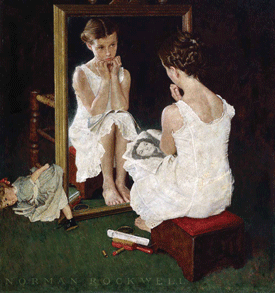American Chronicles: The Art of Norman Rockwell” has been touring the country since the fall of 2007. Since its record-breaking opening at the Akron Art Museum, attendance in every city the exhibition has visited has been high. There is every indication that the tour will attract capacity crowds until it completes its run in spring 2013 in Bentonville, Ark.
Meanwhile, the National Museum of American Illustration in Newport, R.I., sent its show “Norman Rockwell: American Imagist” on the road, which features 322 vintage covers made for The Saturday Evening Post between 1916 and 1963. And in July the Smithsonian Institute will open yet another Rockwell exhibition, “Telling Stories: Norman Rockwell from the Collections of George Lucas and Steven Spielberg.”
Though often spurned by critics, Norman Rockwell has always been popular. David Kamp, a contributing editor to Vanity Fair, recently noted that the beloved painter, whom many called an illustrator but not an artist, is enjoying a re-evaluation by the artistic intelligentsia. “It has taken a while,” wrote Kamp, “but the nose-holding ambivalence with which educated people have been conditioned to treat Rockwell—He’s good in a corny backward, non-art sort of way—is giving way to outright admiration.”
Understanding why the critical attitude has changed may offer insight into the role of sacred art. What does good art accomplish where the trivial fails? What sort of art should be in our churches? What is art, especially sacred art, supposed to do? The answer may be as simple and supple as a Rockwell painting. Good art could be called incarnational, because it uses material to nourish the spirit. Art helps us to perceive aspects of reality we could not see otherwise. This is not a struggle between old art and new or between representational and abstract art. Each can reveal what we have never before seen, or each can simply tread a tired trail.
As shown in the new book Norman Rockwell: Behind the Camera, by Ron Schick, published in collaboration with the Norman Rockwell Museum in Stockbridge, Mass., the question is not whether Rockwell was an illustrator. He was. Unlike conceptual art, which seeks to evoke only a notion or an emotion, the nature of illustration embraces narration and storytelling, an attribute it shares with medieval stained glass windows, which taught the Gospel by means of visual imagery.
“I love to tell stories in pictures,” Rockwell said. “For me, the story is the first thing and the last thing.” Rockwell labored diligently, first conceptually and then physically over the clothes and artifacts, the postures and profiles of his carefully composed subjects. Then he would photograph them before turning them into illustration. “In my opinion nothing should ever be shown in a picture which does not contribute to telling the story the picture is intended to tell.”
Behind the Camera presents the photographed subjects with whom Rockwell worked. The Stockbridge museum has put much of the same content on ProjectNORMAN, a new section of its Web site, nrm.org. Examining these photos, one can argue that Rockwell could have been considered a great artist as a photographer alone thanks to the human reality he captures in his carefully organized photographs (see cover). His hands refashion everyday subjects into grace made visible, which is what elevates his work.
Keats perfectly defined kitsch when he rejected poetry “that has a palpable design upon us.” That flaw is what Peter Schjeldahl, The New Yorker’s art critic, finds in Rockwell. “The complete absence of mystery in his art makes me sick,” wrote Schjeldahl.
But great art is not synonymous with obfuscation. As the literary critic George Steiner has pointed out, “there are countless texts, paintings, statues—perhaps even the Moses of Michelangelo, so talismanic to Freud—whose strength, whose enunciations of organized sense, lie ‘at the surface.’”
Consider Rockwell’s “Girl at the Mirror” (above). An 11-year-old girl sits on a stool in front of a large mirror. Dressed in a slip, she’s been busy with her toilette. A comb and brush lie at her feet, as does her mother’s lipstick. Her doll, arms akimbo, is face down. The childhood friend has been momentarily abandoned. In the girl’s lap lies a glossy movie magazine, open to a full-page spread of Rita Hayworth.
Although Rockwell’s painting captures only a single moment, it’s clear to the viewer that the girl’s eyes have swung repeatedly between the glamorous woman in the magazine and her own image in the mirror. She’s a pretty girl, but lacks Hayworth’s cheekbones and lustrous, wavy hair. Of course, at 11, she does not expect to possess these things. But what if she never does? Who is she? Who will she become? Some people stare into mirrors because they already like what they see, but most of us keep looking, hoping that sooner or later we will see the person we’ve been looking for. Part of the journey from youth to old age includes pondering who we are, who we will become and wondering how we became who we are. That first question, the one adolescents ask—“Who am I?”—is an important one.
It is strange that Rockwell’s critics never anchored him in Aristotle, who thought representation the very purpose of art and presumed that good art always carried emotional heft.
Michael Kimmelman of The New York Times credits Rockwell with producing “a people’s history of America during the first half of the century.” Kimmelman explained, “He reminded people that the little things sometimes matter more than we think, and we could say the same about his pictures.” Often Rockwell used his neighbors as models. As he said, “I paint human-looking humans and the professional models just don’t qualify,” adding, “All of the artist’s creativeness cannot equal God’s creativeness.”
The Sacred Real
Art that reveals, that finds the truly human, may or may not be “pretty.” A good example is a statue of the Madonna in the chapel of the Catholic Care Center in Wichita, Kan. It is a contemporary piece in vibrant colors that depicts Mary as an old woman. From a distance it looks like a life-size candle figurine, one that has begun to melt after exposure to heat. Come closer and you realize that the artist has captured time’s wrinkles and an old woman’s girth. This is the Virgin long after the birth of the Messiah and his earthly life, beyond the many years of prayerful, patient waiting for his return. She is old and weathered but beautifully faithful.
The French philosopher Jacques Maritain insisted that “artistic creation does not copy God’s creation, it continues it.” Good art helps us to perceive something of this world’s truth and, this world’s beauty. By helping us see that loveliness, it helps us to see God. Though as Sam Mendes’s 1999 film “American Beauty” shows, for example, the beautiful that we see in art may well be the easily overlooked ugliness of quotidian life, something as simple as a plastic bag blowing in the wind.
Consider two further examples of art that elevate the quotidian—two cathedrals. The clear glass windows of San Francisco’s modern cathedral, St. Mary of the Assumption, frame the everyday cityscape at ground level, while its vault reaches up in a vortex toward heaven. Perhaps the best feature of the second cathedral, Our Lady of the Angels in Los Angeles, is the way it claims and makes sacred a portion of the real-life L.A. sprawl. Its surrounding courtyard walls jut out to embrace an adjacent freeway. Like a Spanish colonial mission, the walls create a sanctuary. Both churches find ways of claiming their cities for Christ, of revealing the divine presence suffering the urban reality. They are examples of modern art at its best, because they find tangible ways to connect our modern, ever more urban narrative to the divine.
The Second Vatican Council’s “Constitution on the Sacred Liturgy” noted “the church has not adopted any particular style of art as her very own; she has admitted styles from every period according to the natural talents and circumstances of peoples, and the needs of the various rites.” The council insisted that the arts “by their very nature, are oriented toward the infinite beauty of God, which they attempt in some way to portray by the work of human hands.”
Since the Gospel is a proclamation, the “success” of liturgical art depends on its ability to communicate. For instance, I have yet to see good, conceptually stark Stations of the Cross. The Stations are a narrative medium and demand illustration of the sort Rockwell offered. Stained-glass windows, by contrast, do well without being realistic; color and symbols carry the weight, as they do in the masterful work of Marc Chagall.
Still, most people prefer more narrative pieces in churches. Are they artistic philistines? Or do they intuitively grasp, as Norman Rockwell did, that the Gospel is all about narrating grace?









What a truly wonderful assessment of the value of art to our faith. Brilliant and so encouraging to those of us who love them both.
Loved the article about Norman Rockwell! Am I the only one who thinks that the movie star in the magazine at the little girl's feet ("Girl At Mirror") is not Rita Hayworth, but Jane Russell?